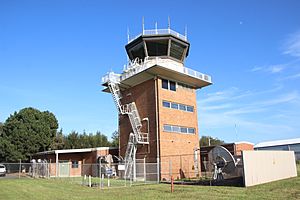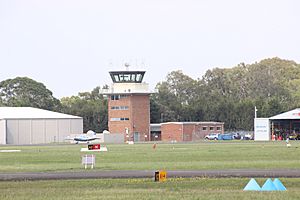Bankstown Airport Air Traffic Control Tower facts for kids
Quick facts for kids Bankstown Airport Air Traffic Control Tower |
|
|---|---|

The control tower in October 2018
|
|
| Location | Tower Road, Bankstown, Sydney, New South Wales, Australia |
| Official name: Bankstown Airport Air Traffic Control Tower | |
| Type | Listed place (Historic) |
| Designated | 22 January 2016 |
| Reference no. | 106118 |
| Lua error in Module:Location_map at line 420: attempt to index field 'wikibase' (a nil value). | |
The Bankstown Airport Air Traffic Control Tower is a special building in Bankstown, Sydney, New South Wales, Australia. It's where people called air traffic controllers work. Their job is to guide planes safely in and out of the airport. This tower is so important that it's listed on the Australian Commonwealth Heritage List since January 22, 2016. This means it's a protected historical site!
Contents
Why Bankstown Airport Needed a New Tower
In the 1950s and 1960s, Bankstown Airport became super busy. Imagine, the number of planes taking off and landing each year jumped from 100,000 to 280,000 between 1962 and 1967! It was like a highway for small planes.
Because of all this growth, Bankstown became known as the main place for general aviation in Australia. This means it was a hub for smaller planes, flying schools, and private aircraft, not huge passenger jets.
To handle the increasing traffic, the airport got many upgrades. They added longer, paved runways and even installed lights so planes could land at night.
In 1968, the government department in charge of air travel, the Department of Civil Aviation, decided it was time for a brand new, taller air traffic control tower. This new tower, along with its power and equipment rooms, cost about $250,000. It was built on the western side of the airport and opened in 1970.
What the Control Tower Looks Like
The Bankstown Airport Air Traffic Control Tower stands on Tower Road. It includes the main tower and a building at its base. The whole area is about 300 square meters and is surrounded by a fence for safety.
The control tower is made of strong materials like reinforced concrete and brick. It has a square base with four stories. Above that, there's a rectangular walkway that sticks out, and then the main control room, called the cabin, which is shaped like an octagon. The cabin floor is about 15 meters (or 50 feet) above the ground, giving controllers a great view!
There's also a smaller brick building next to the tower. This building holds important radio equipment. A separate power house is also nearby. Both of these buildings were part of the original design and are still used today.
Outside the Tower
The tower's main side, facing the airport, has long, narrow windows on the first, second, and third floors. These windows help light up the inside. The other sides of the tower are mostly solid brick, except for some windows on the west side that light the stairs.
A simple wooden door on the west side is the main entrance. There's also a modern steel fire escape that goes from the top walkway down to the ground.
The very top of the tower, where the controllers work, has special windows that are double-glazed and tilted outwards. This helps reduce glare and noise. On the roof, you can see a central light beacon, which is like a lighthouse for planes, and many antennas for communication.
Inside the Tower
When the tower was first built, each floor had a specific purpose. The first floor had a switch room and a technical officer's room. The second floor was for the officer-in-charge and a check controller. The third floor had a staff locker room and bathrooms.
The inside of the tower hasn't changed much over the years. The ground floor has a large room for the air conditioning system, which keeps the tower cool. The stairs are made of concrete with white metal railings and black plastic handrails.
The first, second, and third floors have similar layouts, with rooms facing the airport. There's also a small storage room on some floors. The bathrooms on the third floor were updated a few years ago.
From the third floor, another set of stairs leads up to the control cabin. This is where the air traffic controllers sit. The cabin still has its original central wooden console, though it's been updated with new technology. The windows are designed to reduce noise and glare. The ceiling has special tiles to absorb sound, and the floor is carpeted.
Why This Tower is Special
The Bankstown Airport Air Traffic Control Tower is important because it's a great example of how air traffic control towers were designed in Australia after World War II. It was built to a standard design used for many towers across Australia and Papua New Guinea from the 1950s to the late 1960s.
Even though it's a later example of this type of tower, it's special because it's still very much like it was when it was first built. Most of its outside and inside parts are original. It even has its first wooden control console, which is quite rare! The nearby radio equipment room and power house are also still in their original condition.
This tower shows us how air travel grew in Australia and how important it was to have safe and organized airports.
Images for kids




